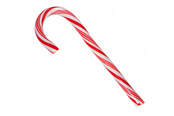|
|
I’ve never been a huge fan of peppermint. I think it’s the mint part. I blame a friend of mine in middle school. He invited me to dinner, and they had lamb. His father insisted that I try it with mint jelly. It was an extremely unpleasant experience.
However, over time, I learned to appreciate a little mint. I especially enjoy the free Andes' Crème de Menthe mints which are specially made for Olive Garden. Keep the bread sticks and, instead, give me a handful of those bad boys. They are a simple mint comprised of two equal layers—one with chocolate and one with mint. It’s not overpowering and just a hint of mint. When it comes to eating candy canes, I will generally pass. I do find them beautiful in color and love to see them hanging on trees, but I’m just not a huge fan of the taste. Candy canes are considered to be a seasonal treat. It probably doesn’t surprise you that ninety percent of candy canes sold each year are purchased between Thanksgiving and New Year’s Day. They are the number one selling non-chocolate candy in the month of December. Many are used for decorations, but many are actually eaten. You should try them with lamb (just don’t invite me). If we saw someone eating a candy cane in mid-July, we might assume that someone had some leftover Christmas candy they needed to dispose of. According to the National Candy Association (yes there is such a thing and no they are not hiring), making candy canes is quite the detailed process. They are made by heating sugar and corn syrup in large kettles and then vacuum cooked. After heating, the candy mixture is poured on a cooling table and peppermint and starch are added to hold in the flavor and prevent the mixture from becoming too sticky. The mixture is then placed in a kneader. At this point, the mixture is a brownish color. Then, it is placed into a puller and, during this process, the candy turns bright white. Next, the circular shape is formed, the stripes are added, and the candy is cut and placed in wrappers—still warm. Last of all, they are bent into the shape of a shepherd’s cane. As difficult as they are to make, determining their history and purpose is somewhat of an intriguing mystery. Candy canes first appeared as a straight piece of candy and were entirely white in color. According to some sources, the candy cane underwent revision in the late 1670s. Tradition says, a choirmaster in Cologne Cathedral in Germany used the hard candy to try to keep the children quiet during the long service (good to know that even that long ago children were appeased with sugary treats). He even gave it the bend at the top to form it into a shepherd's staff. The candy cane did not make an appearance in the U.S. until the mid-1800s and underwent little change. By the 1920s, a man named Bob McCormack of Albany, Georgia began making candy canes as special Christmas treats for his own children and other friends around town. It was quite the undertaking for McCormack as the mixture had to be pulled, twisted, bent, and cut by hand. Most believe it was in the 1920s that the red stripes were added although no one really knows why. In the 1950s, McCormack’s brother-in-law, Gregory Keller, a Catholic priest, devised a process to automate the production of the candy cane thus opening up the opportunity for them to be created and consumed on a larger scale. The rest is history. Well, I guess all of that is history. Because of the ability to mass produce the candy cane, they went viral—and that was before the Internet. Candy canes are a cute, fun, and to some people, are a tasty treat. They’re relatively inexpensive and make a great decoration on the tree. But they can also be used for something more beautiful and meaningful. Although no one really knows exactly why the candy cane was created, there are some cites out there that claim that they were created to teach children about Jesus. I’m not sure if this is truly historical, but I would suggest that, entirely accurate or not, candy canes are a great way to teach children—and others—about Jesus. Here’s how: The Shape: Most candy canes are in the shape of a shepherd’s staff. The Bible says, “The Lord is my shepherd” (Psalm 23:1). Psalm 23 is a great reminder that God is a heavenly shepherd who takes care of His flock. In addition, Jesus said, “I am the good shepherd. The good shepherd lays down his life for the sheep” (John 10:11). Jesus is the Good Shepherd who leaves the 99 to rescue the wandering or missing lamb. Another interesting note, for English speaking people anyway, is that if you turn the candy cane upside down, it’s the letter “J” which stands for Jesus. It’s a great way to teach the little ones about Jesus, the Great Shepherd. The feel and smell of the candy cane: The candy cane is hard like a rock. Similarly, the Bible reminds us that Jesus is our rock. He is the foundation upon which we must build our lives and is also our fortress and protection. The Bible says, “The Lord is my rock, my fortress and my deliverer; my God is my rock, in whom I take refuge, my shield and the horn of my salvation, my stronghold” (Psalm 18:2). In Matthew 7, Jesus reminds us to build our lives upon the solid rock. The colors of the candy cane: Although originally white, candy canes are now generally red and white. The white reminds us of Jesus’s purity and holiness. The red represents the blood that Jesus shed for us on the cross. Interestingly, many candy canes have 3 thin stripes. No one knows when these were added. However, these 3 thin stripes have been used to talk about the “stripes” that Jesus bore. As Isaiah said, “But He was wounded for our transgressions, He was bruised for our iniquities; The chastisement for our peace was upon Him, And by His stripes we are healed” (Is 53:5). The stripes can also be used to illustrate the Father, Son, and Holy Spirit. Candy canes have a long, veiled, but interesting past. They can be used to express holiday cheer and make wonderful decorations. Candy canes are a part of the season and will likely be around for a long time. In addition, the candy cane can be used to bring glory to God and illustrate the true reason for the season—the true Lamb of God. Wayne Geiger is the Pastor of First Baptist Grain Valley, an Adjunct Associate Professor of Speech, and freelance writer. Comments are closed.
|
Categories
All
Archives
July 2024
|
Grain Valley NewsGrain Valley News is a free community news source published weekly online. |
Contact Us |


 RSS Feed
RSS Feed
